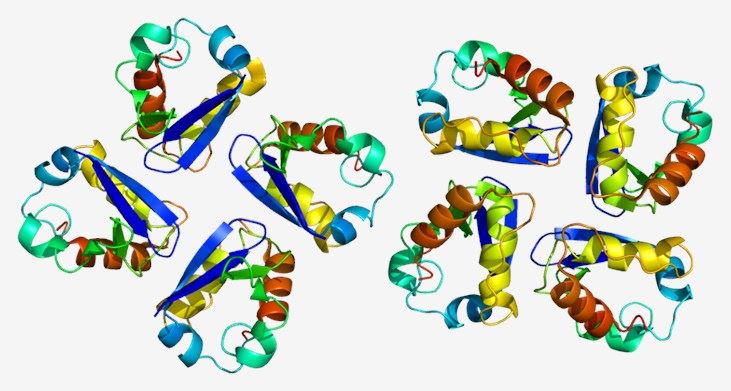Introduction of KCNA3
KCNA3, encoded by KCNA3 gene, is a member of potassium channel, voltage-gated, shaker-related subfamily which regulates the transportation of potassium ions across membrane in accordance with their electrochemical gradient. The channel is composed of four subunits which interact with Kvβ subunit tetramer. Each subunit has 575 amino acids and contains 6 transmembrane segments (S1-S6) with a shaker-type repeat in S4 forming the voltage-sensor, and with the pore region between S5-S6 containing a selectivity filter and gating ion flow.
| Basic Information of KCNA3 | |
| Protein Name | Potassium voltage-gated channel subfamily A member 3 |
| Gene Name | KCNA3 |
| Aliases | MK3, HGK5, HLK3, PCN3, HPCN3, KV1.3, HUKIII |
| Organism | Homo sapiens (Human) |
| UniProt ID | P22001 |
| Transmembrane Times | 6 |
| Length (aa) | 575 |
| Sequence | MDERLSLLRSPPPPSARHRAHPPQRPASSGGAHTLVNHGYAEPAAGRELPPDMTVVPGDHLLEPEVADGGGAPPQGGCGGGGCDRYEPLPPSLPAAGEQDCCGERVVINISGLRFETQLKTLCQFPETLLGDPKRRMRYFDPLRNEYFFDRNRPSFDAILYYYQSGGRIRRPVNVPIDIFSEEIRFYQLGEEAMEKFREDEGFLREEERPLPRRDFQRQVWLLFEYPESSGPARGIAIVSVLVILISIVIFCLETLPEFRDEKDYPASTSQDSFEAAGNSTSGSRAGASSFSDPFFVVETLCIIWFSFELLVRFFACPSKATFSRNIMNLIDIVAIIPYFITLGTELAERQGNGQQAMSLAILRVIRLVRVFRIFKLSRHSKGLQILGQTLKASMRELGLLIFFLFIGVILFSSAVYFAEADDPTSGFSSIPDAFWWAVVTMTTVGYGDMHPVTIGGKIVGSLCAIAGVLTIALPVPVIVSNFNYFYHRETEGEEQSQYMHVGSCQHLSSSAEELRKARSNSTLSKSEYMVIEEGGMNHSAFPQTPFKTGNSTATCTTNNNPNSCVNIKKIFTDV |
Function of KCNA3 Membrane Protein
KCNA3 is highly expressed in the nervous system where it regulates voltage-dependent potassium ion permeability of excitable membranes. It has been revealed that KCNA3 can efficiently promote repolarization of nerve cells following an action potential preventing nerve cells from hyperexcitability. And the abnormal expression of KCNA3 is associated with the pathological process of neurodegenerative diseases including Alzheimer’s disease. Moreover, the high levels of KCNA3 are also found in T and B lymphocytes. KCNA3 has been indicated to exert a very important role in T-cell proliferation and activation. And the deficiency of KCNA3 suppresses T-cell proliferation and activation. Recent studies have been suggested that KCNA3 blockers can selectively inhibit the effect of effector-memory T cells and relieve the symptom of autoimmune diseases without influencing the protective immune response. In rat models, KCNA3 blockers have been found to treat rheumatoid arthritis, delayed-type hypersensitivity, and contact dermatitis so far. In addition, a mutation in the promoter of the KCNA3 gene has been indicated an association with low insulin sensitivity and decreased glucose tolerance. This suggests that KCNA3 can be also regarded as a therapeutic target for obesity and diabetes.
 Fig.1 Structure of the KCNA3 protein.
Fig.1 Structure of the KCNA3 protein.
Application of KCNA3 Membrane Protein in Literature
The study shows that Kv1.3 is a potential therapeutic target for preferentially suppressing "M1-like" inflammatory microglia/macrophage effects in ischemic stroke.
The research shows that a selective Kv1.3 channel blocker ImKTx88 can suppress the activation of T-cell thereby preventing neurological damage. This also suggests that ImKTx88 is an effective drug for the treatment of multiple sclerosis.
The study shows that a specific inhibitor of Kv1.3 channels, 5-(4-phenoxybutoxy) psoralen (PAP-1) can decrease astrogliosis and microglial infiltration, as well as tumor cell invasion.
The study firstly finds the dual functional peptides BF9 which possesses anticoagulant and Kv1.3 channel inhibitory activity. This provides a new sight for treatment of immune and thrombosis-associated human diseases.
In vitro study shows that the blocking of Kv1.3 inhibits the inflammatory response in activated astrocytes, which suggests Kv1.3 may be a therapeutic target for multiple sclerosis.
KCNA3 Preparation Options
To obtain the soluble and functional target protein, the versatile Magic™ membrane protein production platform in Creative Biolabs enables many flexible options, from which you can always find a better match for your particular project. Aided by our versatile Magic™ anti-membrane protein antibody discovery platform, we also provide customized anti-KCNA3 antibody development services.
As a forward-looking research institute as well as a leading custom service provider in the field of membrane protein, Creative Biolabs has won good reputation among our worldwide customers for successfully accomplishing numerous challenging projects including generation of many functional membrane proteins. Please feel free to contact us for more information.
All listed services and products are For Research Use Only. Do Not use in any diagnostic or therapeutic applications.